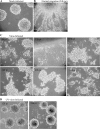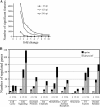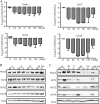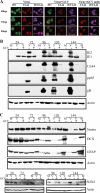Human cytomegalovirus infection causes premature and abnormal differentiation of human neural progenitor cells
- PMID: 20071566
- PMCID: PMC2838134
- DOI: 10.1128/JVI.02161-09
Human cytomegalovirus infection causes premature and abnormal differentiation of human neural progenitor cells
Abstract
Congenital human cytomegalovirus (HCMV) infection is a leading cause of birth defects, largely manifested as central nervous system (CNS) disorders. The principal site of manifestations in the mouse model is the fetal brain's neural progenitor cell (NPC)-rich subventricular zone. Our previous human NPC studies found these cells to be fully permissive for HCMV and a useful in vitro model system. In continuing work, we observed that under culture conditions favoring maintenance of multipotency, infection caused NPCs to quickly and abnormally differentiate. This phenotypic change required active viral transcription. Whole-genome expression analysis found rapid downregulation of genes that maintain multipotency and establish NPCs' neural identity. Quantitative PCR, Western blot, and immunofluorescence assays confirmed that the mRNA and protein levels of four hallmark NPC proteins (nestin, doublecortin, sex-determining homeobox 2, and glial fibrillary acidic protein) were decreased by HCMV infection. The decreases required active viral replication and were due, at least in part, to proteasomal degradation. Our results suggest that HCMV infection causes in utero CNS defects by inducing both premature and abnormal differentiation of NPCs.
Figures






Similar articles
-
Human Cytomegalovirus Infection Dysregulates the Localization and Stability of NICD1 and Jag1 in Neural Progenitor Cells.J Virol. 2015 Jul;89(13):6792-804. doi: 10.1128/JVI.00351-15. Epub 2015 Apr 22. J Virol. 2015. PMID: 25903338 Free PMC article.
-
Nitric Oxide Attenuates Human Cytomegalovirus Infection yet Disrupts Neural Cell Differentiation and Tissue Organization.J Virol. 2022 Jul 27;96(14):e0012622. doi: 10.1128/jvi.00126-22. Epub 2022 Jul 7. J Virol. 2022. PMID: 35862705 Free PMC article.
-
Human cytomegalovirus infection of human embryonic stem cell-derived primitive neural stem cells is restricted at several steps but leads to the persistence of viral DNA.J Virol. 2014 Apr;88(8):4021-39. doi: 10.1128/JVI.03492-13. Epub 2014 Jan 22. J Virol. 2014. PMID: 24453373 Free PMC article.
-
Drug targets in cytomegalovirus infection.Infect Disord Drug Targets. 2009 Apr;9(2):201-22. doi: 10.2174/187152609787847758. Infect Disord Drug Targets. 2009. PMID: 19275707 Review.
-
Human cytomegalovirus infection of human hematopoietic progenitor cells.Leuk Lymphoma. 1999 Mar;33(1-2):1-13. doi: 10.3109/10428199909093720. Leuk Lymphoma. 1999. PMID: 10194116 Review.
Cited by
-
Allicin Inhibits Proliferation by Decreasing IL-6 and IFN-β in HCMV-Infected Glioma Cells.Cancer Manag Res. 2020 Aug 17;12:7305-7317. doi: 10.2147/CMAR.S259677. eCollection 2020. Cancer Manag Res. 2020. PMID: 32884345 Free PMC article.
-
Zika Virus Neuropathogenesis: The Different Brain Cells, Host Factors and Mechanisms Involved.Front Immunol. 2022 Mar 16;13:773191. doi: 10.3389/fimmu.2022.773191. eCollection 2022. Front Immunol. 2022. PMID: 35371036 Free PMC article. Review.
-
Human Cytomegalovirus Compromises Development of Cerebral Organoids.J Virol. 2019 Aug 13;93(17):e00957-19. doi: 10.1128/JVI.00957-19. Print 2019 Sep 1. J Virol. 2019. PMID: 31217239 Free PMC article.
-
Transition toward Human Cytomegalovirus Susceptibility in Early Human Embryonic Stem Cell-Derived Neural Precursors.J Virol. 2015 Nov;89(21):11159-64. doi: 10.1128/JVI.01742-15. Epub 2015 Aug 19. J Virol. 2015. PMID: 26292329 Free PMC article.
-
Transcriptomic profiling of thymic dysregulation and viral tropism after neonatal roseolovirus infection.Front Immunol. 2024 Jun 4;15:1375508. doi: 10.3389/fimmu.2024.1375508. eCollection 2024. Front Immunol. 2024. PMID: 38895117 Free PMC article.
References
Publication types
MeSH terms
Substances
Grants and funding
LinkOut - more resources
Full Text Sources
Medical
Molecular Biology Databases
Research Materials

